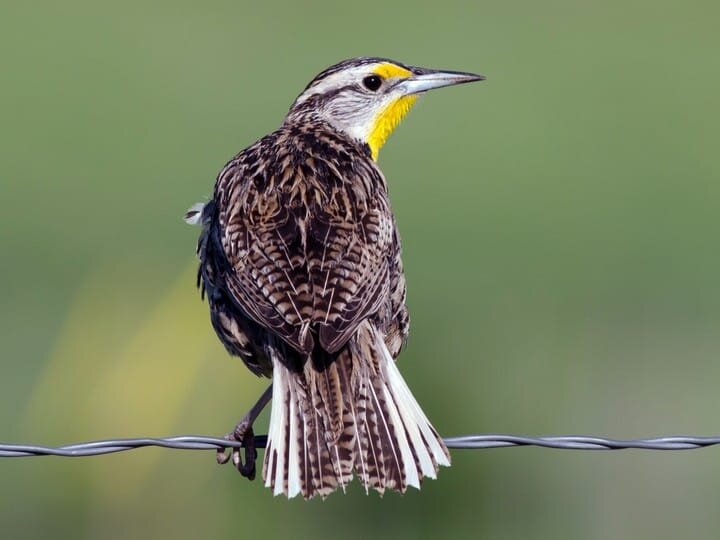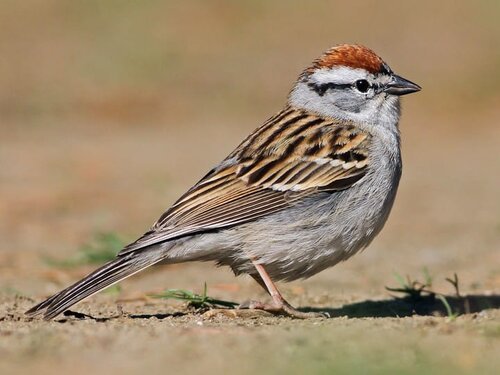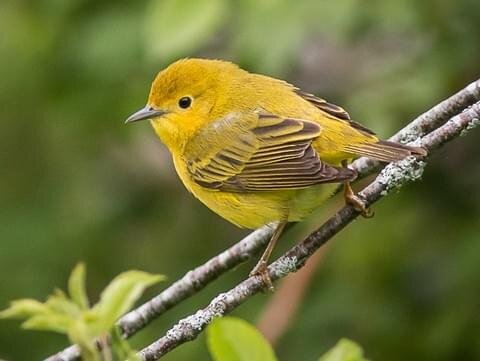Week 7: Advanced
Scroll down to study the birds by sight and sound, and then take the quiz.
Week 7 Birds
Blue-gray Gnatcatcher, Bullock’s Oriole, Black-chinned Hummingbird, Western Kingbird, Western Meadowlark, Chipping Sparrow, Orange-crowned Warbler, Yellow Warbler












Bullock’s Oriole
Bird Code: BUOR
Identify this bird by…
Medium-sized songbirds with slim but sturdy bodies and medium-long tails
Very sharply pointed bill
Tell males and females apart by…
Males - Bright orange with a black back and large white wing patch. The face is orange with a black line through the eye and a black throat
Females - yellowish-orange on the head and tail, with grayish back and white-edged wing coverts (also juveniles)
Immature males look the same but show a black throat patch
Look for…
Behavior - they feed in the slender branches of trees and shrubs, catching caterpillars and also feeding on nectar or fruit. They are agile and active, often hanging upside down or stretching to reach prey
Listen for …
Song: About 3 seconds long, composed of rich whistled notes interspersed with rattles, often introduced by gruff scratchy notes
Call: A harsh, chattering rattle
Resources:
Blue-gray gnatcatcher
Bird Code: BGGN
Identify this bird by…
Tiny and slim with long legs and thin, straight bill
Long dark/black tail with white outer tail feathers
White eyering
Non-breeding males and females look alike
Tell males and females apart by…
Males - In breeding plumage, have a black “V” extending above their eyes. Blue/gray on back
Females - Gray on back with a thin white eyering
Look for…
Behavior - energetic and rarely slows down, fluttering after small insects among shrubs and trees with its tail cocked at a jaunty angle
Listen for…
Song: Song is wheezy and harsh. Listen for the buzzy call at the beginning: szeewv!
Call: A whining pwee.
Resources:









BLACK-CHINNED HUMMINGBIRD
Bird Code: BCHU
Identify this bird by
Small, fairly slender hummingbird with a fairly straight black bill
Dull metallic green above and dull grayish-white below
In both males and females, the flanks are glossed with dull metallic green
Tell males and females apart by…
Males: Have a velvety black throat with a thin, iridescent purple base
Females: Have a pale throat. Their three outer tail feathers have broad white tips
Look for…
Behavior - Hovers at flowers and feeders, darts erratically to take tiny swarming insects, perches atop high snags to survey its territory, watching for competitors to chase off and for flying insects to eat
Listen for…
Call: Soft, flat “chew” notes, often in series with soft high squeals, chips, and ticks. Their wings also give a low-pitched humming sound
Resources:
Western Kingbird
Bird Code: WEKI
Identify this bird by…
Fairly large flycatchers with large heads and broad shoulders
Heavy, straight bills, long wings
Medium-length, square-tipped tail
Males and females look alike
Tell it apart by…
Pale gray head
Dark tail with white outer tail feathers visible in flight
Yellow belly and whitish chest and throat
Look for…
Behavior - They “hawk” insects from the air or fly out to pick prey from the ground. They ferociously defend their territories with wing-fluttering, highly vocal attacks
Listen for…
Song: The WEKI song is a series of fast, impulsive, bickering vocal bursts. It sounds like an audiotape in fast-forward
Call: Sharp kip notes and squeaky twitters
Resources:









Western Meadowlark
Bird Code: WEME
Identify this bird by…
Flat head and long, slender bill
Round-shouldered posture that nearly conceals its neck
Tell it apart by…
Yellow underparts with intricately patterned brown, black and buff upperparts
Black “V” crosses the bright yellow breast; it is gray in winter
Contrasting stripes of dark brown and light buff mark the head
The outer tail feathers flash white in flight
Look for…
Behavior - In spring and summer, males sing out from atop fence posts, bushes, power lines, and other high points
Listen for…
Song: The WEME song is loud, buoyant, flutelike, and melodious. Although the song phrasing can change between songs, the tone is very distinctive
Call: A low, bell-like pluk or chupp
Resources:
CHIPPING SPARROW
Bird Code: CHSP
Identify this bird by…
Bright, rusty crown and black eyeline
Unstreaked grayish belly. Gray rump visible in flight
Immature individuals have brown streaked crown and buffy gray underparts with thin streaks
Males and females look the same (not dimorphic)
Look for…
Behavior - feed on the ground, take cover in shrubs, and sing from the tops of small trees
Listen for…
Song: Male Chipping Sparrows sing a long, dry trill of evenly spaced, almost mechanical-sounding chips – but be careful, because Dark-eyed Juncos sound very similar (though a bit more musical) and often live in the same habitats.
Call: Both sexes use a single chip note to stay in contact with others
Resources:




ORANGE-CROWNED WARBLER
Bird Code: OCWA
Identify this bird by…
Thin, pointy bill
Yellow-olive overall with faint eye line
Yellow under-tail coverts
Males and females look the same (not dimorphic)
Look for…
Behavior - Forage in dense shrubbery and low trees. They tend to be quiet and unobtrusive, although their low foraging habits can help you spot them. They often give a high, faint contact call while foraging.
Listen for…
Song: Males sing a trilling song of sweet, clear notes. The song can remain on a single pitch or it can rise slightly in the middle and end on a distinctive rising or falling note—chee chee chee chew chew. The song pattern varies enough that individual males can be told apart by the version they sing
Call: a simple, sharp, high-pitched chip, distinctive from that of other warblers
Resources:




YELLOW WARBLER
Bird Code: YEWA
Identify this bird by…
Small, evenly proportioned songbirds
Straight, thin, bill is relatively large
Both males and females flash yellow patches in the tail
Unmarked face that accentuates black eye
Yellow-green back
Tell males and females apart by…
Males: Bright, egg-yolk yellow with reddish streaks on underparts
Females: Yellow overall with unstreaked yellow underparts
Look for…
Behavior - Look for them near the tops of tall shrubs and small trees. They forage restlessly, with quick hops along small branches and twigs to glean
Listen for…
Song: Song has a very sweet tone. It is a series of 6-10 whistled notes that accelerate over the course of the song and often end on a rising note. A mneumonic to help remember the rhythm and sweet tone is “sweet-sweet-I’m-so-sweet!”
Call: a variety of short chip notes, some with a metallic sound and some with a lisping or buzzing quality.
Resources:
WEEK 7 WETLAND EXTRAS
Study these birds if you are interested in surveying at Legacy Nature Preserve, the Great Salt Lake Shorelands Preserve, and Utah Lake North Shore.



LONG-BILLED DOWITCHER
Bird Code: LBDO
Identify this bird by…
A chunky shorebird with a very long bill
Breeding adult have a rufous neck with dark streaks, barring on the side of the breasts, and darker brown above. Non-breeding adults and immature birds are a dull gray with narrow rufous edging on wings.
Show a white rump, gray underwing, and pale secondaries in flight.
Are often seen foraging with a sewing-machine probing behavior.
Listen for…
Call: A high, sharp “keek” in flight, or soft chatter when foraging.
Resources:




Virginia rail
Bird Code: VIRA
Identify this bird by…
Chickenlike marsh bird with a long, heavy bill
Short, upturned tail
Head on, the Virginia Rail looks thin, but from the side they look rather full-bodied
Tell it apart by…
Rusty overall with a gray face, coarse dark streaking down the back
Black-and-white barring on the sides
White undertail feathers.
The bill and legs are reddish
Look for…
Behavior - walk with a somewhat jerky motion through wetlands. They often twitch their upturned tail to show off the white undertail feathers
Listen for…
Song: The birds give a repeated tick-it
Call: Pig-like grunts
Resources:



SORA
Bird Code: SORA
Identify this bird by…
A small secretive rail, sometimes seen walking along the edges of vegetation in wet marshes.
Plump with a short tail that is often held up. Has a brown back with dark spots and white speckles, a gray breast, and a bright yellow bill that contrasts with a dark face
Listen for…
Call: a two-note “sora” with the second note higher in pitch
Song: a descending whinny that lasts two to three seconds
Resources:



LONG-BILLED CURLEW
Bird Code: LBCU
Identify this bird by…
Extremely large, long-legged shorebird with a very long curved bill
Buffy brown with pale cinnamon underparts and a rusty cinnamon underwing that can be seen in flight.
Listen for…
Song: has a distinctive rising and then falling display song
Resources:




WILLET
Bird Code: WILL
Identify this bird by…
A large, stocky, drab shorebird with long legs and a straight bill.
Gray and plain-looking when on the ground with barring on breast in breeding Adults.
In flight, show a striking black and white wing pattern and white rump
Listen for…
Song: a very distinctive repeated “will-willet, will-willet, will-willet” display song.
Resources:
All About Birds (link to all about birds profile)
